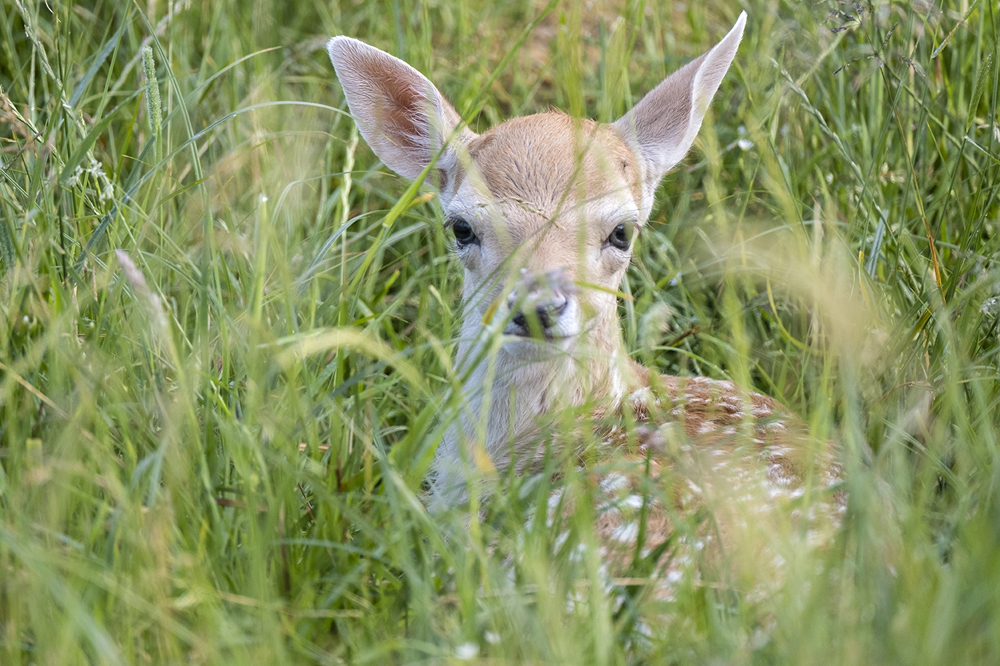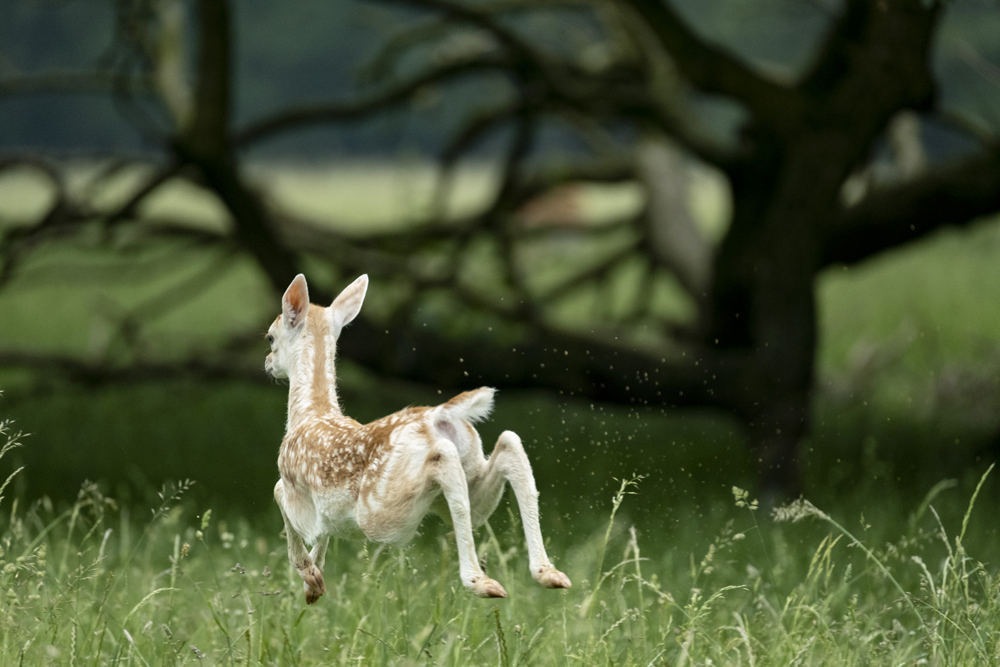It’s easy to take the intricacies of nature for granted until you take the time to observe how it all fits beautifully together. With a project like this, where the life of the deer park is a major focus, the time when the newborns arrive has to be a key point on the calendar.
For the birdlife, the woodpeckers, greylag geese and tree creepers for example, the arrival of their young coincides with the abundance of the food they eat. Caterpillars and many insects emerge in April and May so this is when their young hatch too.


There are both green and greater-spotted woodpeckers in the park. The greater-spotted are more elusive – I seen them only twice from distance. The green, however, are very noisy but never let you get too close, or close enough to get good shot.
The great oak trees at Helmingham are perfect places for high nests, safe from predators. In the hollow of one tree, about 10-12 metres up, I found a green woodpecker nest. Over the period of a few weeks I returned numerous times but, although I could see the twigs inside at the front, I never managed to see the birds. I guess this one of the major drawbacks of doing a project in my spare time, rather than being onsite and able to just spend the daylight hours waiting.




However, while patiently observing this nest one day, I became conscious of a gentle noise just behind me. Less than 10m metres away, the bark was flaking off an old leaning tree. Climbing up the trunk was a tiny tree-creeper, its beak loaded with insects and a green caterpillar. It went in behind the bark and, through a small hole in it, I could see it move up inside towards the chirping chicks.
I watched for a while and very soon a pattern emerged. There were two, a female and a male. What I’d observed first was the female returning to the nest, but the male was also bringing food, although by a different route. The male’s landing spot was higher up, above the nest, on the opposite side of the tree’s trunk. It then came around it and down to enter the well-protected nest behind the bark through the same entrance.
These were very busy birds! Every minute or so one of the pair would bring a beak full of food to the nest, alternating with the other in a predictable dance. Of course, this is ideal for a photographer because you know exactly where each bird will land and move on the tree trunk towards the nest. And I could get pretty close to, which is useful as tree creepers are very small, almost wren-like.
I was told that the deer have their young in June and July but if I was going to get photos of the fawns when they were very young, I needed to be more specific than this. Visiting in early June there was no sign of fawns. Just a little bit too early I suspected, but by mid-June I found the first one – a Fallow – in the Oak Grove. However, there was no sign of any others so I suspected that this one might have been premature.
The clue to the timing was in nature again. As the days lengthened and the summer heat became more intense, the meadow grasses shot up in height, providing the perfect cover for the young fawns. Within the space of a day or two there were suddenly lots of young Fallow deer, especially where there was this good cover.
The mothers with young are understandably skittish, especially earlier in the day. I couldn’t get anywhere near them in the mornings but by late afternoon when it was hot this was easier. To get really close to photograph them, though, required some knowledge of animal behaviour, as is almost always the case with wildlife photography. The young rest in the long grass. As you approach, the mothers move away to distract and draw you away while the fawns drop down and hide in the cover. To find them you either need to get really lucky or have marked exactly where they were when they dropped into this long grass. If you don’t, their camouflage is so good and they stay so still, it’s highly likely that you won’t find them even if you’re within a few metres. Once you understand this behaviour, and with patience, persistence and a keen eye, it’s possible to get really close. You need to move very slowly and quietly though.

So that’s the easy bit! Once you’ve found a fawn and got close – may be as close as 2 to 3 metres – you then discover another problem which you need to be prepared for it because the fawn is unlikely to stay long once its been spotted. This problem is focus. Inevitably there will be stems of tall grass in front of the deer’s face, the key point of focus. So if you are using autofocus you will need a small focus point and may also have to lean your upper body or head slightly to position it on the fawn and avoid the grass. Your only option is leaning. If you move at this close distance the fawn will spook and run off.


The other alternative is to use manual focus. To get in close you’ll need a long lens, so the shutter speed will be fast to avoid camera shake, even in bright light. It’s likely you have, and probably want, a narrow depth of field so focus is a tricky and precise process. If the fawn bolts, the faster shutter speed may also allow you to get a shot of it in motion.
Persistence is important. It’s likely you’ll have some, maybe many, failures with focus and movement. If the fawn does run off, watch it carefully. It’s likely that it will drop in the long grass or undergrowth again within about 40 to 100 metres, giving you another chance. Even then it’s not easy. On numerous occasions I’ve noted where the fawn disappeared but still couldn’t find it again!




I found that the shady top end of the Oak Grove in late afternoon or early evening, when the temperature was starting to drop, was a great place to get shots of fawns with mothers or fawns playing with each other. Here I could get reasonably close if I approached slowly from down-wind, under cover of the trees and with a long lens.
When they’re playing, the Fallow fawns are funny. They run around very quickly with their long gangly legs going in every direction. It entertaining just to watch.
The red deer produced their young a few weeks later, around mid-July. Getting close to them is even harder. In the end about 50 metres from behind a tree was about the closest I managed. I had little choice as to the background I could photograph them against, so a shallow depth of field was used to through this out of focus and isolate them. With more persistence, all day to wait and camouflaged, they would probably have come closer to me or I could have decreased this distance. Again, this wasn’t possible unless I was resident onsite and a familiar, unthreatening presence for the deer.
When photographing animals and birds like this, you gain a huge respect for fellow wildlife photographers. Their patience alone is incredible but their knowledge even more so. A wildlife photographer friend of mine once told me that wildlife photography is 90% animal behaviour. Very quickly you come to understand and appreciate this, with the exception of the odd lucky shot, when you’re photographing in the wild.




On my last visit to find the red deer fawns I heard a couple of green woodpeckers in an oak tree just on the west side of the Oak Grove, where I’d found the nest a month or two earlier. As I approached they flew on to the next tree. Approaching that, they then flew into the oak grove towards the nest tree which I’d identified and, with a great cacophony, were joined by three others, presumably their young. It was rather magical to see five green woodpeckers together even though there was no chance of getting a decent photo.


In the next instalment I’ll be back in the deer park as summer burns itself out and the rutting season approaches.

